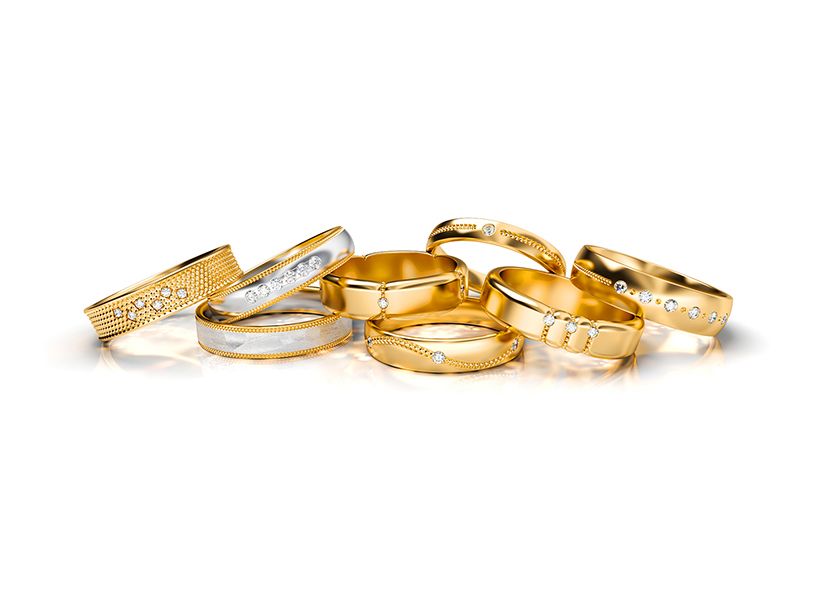
Tips for Designing a Men’s Wedding Ring
When you design a set of wedding bands in the Design Center, you don’t have to design a pair of identical bands. You can customize each ring according to your own needs and preferences. While some people prefer an identical set, other couples like to begin with a theme or design element that their two rings will share in common and then add their own individual flair.
For a lot of men, even just a simple gold wedding band just gets in the way when you’re at work. You don’t want to just leave your ring at home, but at the same time, you don’t want to constantly take it off and put it back on. That’s how you lose it. No matter what kind of work you do or what kind of style you’re going for, we can design a wedding band that looks great and works for you. Whether you put function over form or are looking for a way to integrate both in a practical yet meaningful design, here are some things to think about.
Profile and Dimensions
It doesn’t matter if the tools you work with are a wrench and ratchet or a keyboard and mouse, one thing’s for sure: a heavy, thick ring can get in the way. If you’re not someone who normally wears rings or you feel like a ring is going to take some time to get used to, keep that in mind when selecting a profile, as you’ll probably want something that doesn’t stick out too far from the finger. Lowering the ring height can also help you maximize comfort.
There’s also the width of the ring to consider. Men’s wedding bands tend to be wider, and a wider band looks better on a larger finger, but a ring that’s too wide could keep you from fully flexing your finger. As you’re experimenting with different profiles, heights, and widths, click the little hand icon to see what the ring would look like on a finger.
As for sizing, our rings go as large as size 15. That’s 23mm or almost an inch in diameter (ring sizes are measured in diameter—the width of your finger—and not circumference, or the distance around the finger). Don’t know your ring size? Get a free ring sizing kit here.
Metals
We offer platinum, palladium, and a few different gold alloys in the Design Center. Gold and platinum are durable, but they’re both malleable metals and not scratch resistant. While your platinum ring can accumulate scratches if you’re not careful with it, the metal is malleable enough that scratches can be buffed out. When platinum is scratched, the metal just gets moved around, not chipped off. Think of it like sticking your finger in clay: the clay just gets moved to the side, and you can smooth it out again. Obviously clay is a lot softer than metal, but you get the idea.
Neither platinum or gold will rust or tarnish, but platinum will acquire a patina with wear. Some people like the look of platinum patina as a symbol of the passage of time, of age and experience. If you don’t like the look of it, it’s easy to buff away. If you work with your hands or are constantly picking up or touching things, the bottom of the ring will likely acquire a patina before the top.
Palladium is a little harder than both platinum and gold and is therefore more scratch resistant. Its grayish color coupled with a surface finish like a satin brush or sandblast will result in a look that is great for everyday wear, at once luxurious and rugged.
Colors
We offer more than just yellow gold. By alloying gold with different metals, we can create 18k or 14k red, peach, or white gold. If you don’t like the look of yellow gold, you want something a little more modern, or you just want to create something more unique and meaningful to you, take a look at our colored gold options. To learn more about the different gold alloys you’ll find in the Design Center, check out this blog.
Diamonds
If you’re particularly active, you might shy away from adding diamonds to your wedding band. What if you smack your ring against something and lose a gemstone?
That’s not an issue with our rings. Our diamond settings are engineered to last. Instead of prongs holding the diamond up and away from the ring, we use a variety of settings, such as the tension ring, channel, and bezel settings, that let the diamond rest almost flat against the surface of the ring. These settings are safe, secure, and practical, but they also give your wedding band a touch of luxury you can feel good about wearing anywhere, every day.
The tension ring setting is a particularly ingenious piece of engineering. In a tension ring, the ring is designed to exert pressure on the gemstone. It’s such a strong setting that only the hardest gemstones, like diamonds, can stand up to the pressure. It would take a pretty hard direct blow to dislodge the stone from this kind of setting.
Engraving
Even if you’re just looking for a no-frills, classic gold wedding band, there is one customization option you might want to give some thought to: a custom engraving on the inside of your wedding band, something only you can see, something important that reminds you of what makes your relationship so special. Maybe it’s the date you met, fingerprints, and ECG, or something else. The only limit is your imagination. To help get the creative juices flowing, we listed a few ideas for engravings here.
There’s No Need to Compromise on a Wedding Band
You don’t have to find a compromise between getting the ring you want and the ring you need. Let’s work together to design a ring that looks great on you without getting in the way.